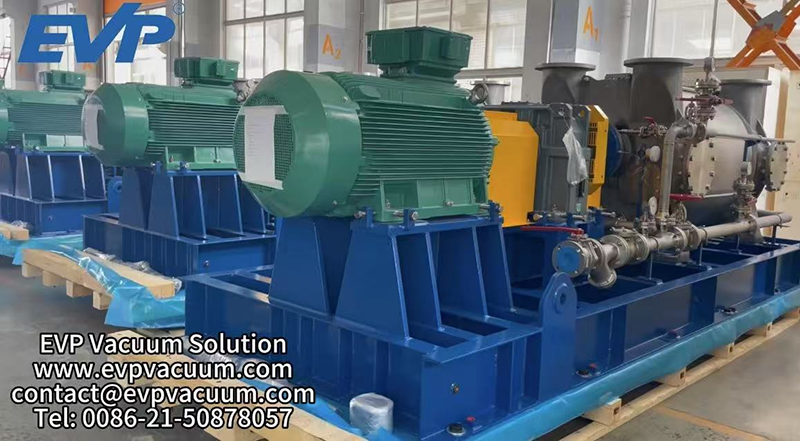Liquid ring vacuum pumps are used in fertilizer plants
Liquid ring vacuum pumps play a vital role in fertilizer plants, primarily due to their simple structure, smooth operation, corrosion resistance, ability to handle wet gases and gases containing liquid droplets, and relative safety when pumping corrosive or flammable/explosive gases. Fertilizer production processes (such as synthetic ammonia, urea, nitric acid, phosphate fertilizers, etc.) involve numerous stages requiring vacuum pumping or gas compression, making Liquid ring vacuum pumps highly suitable equipment.
Key Application Scenarios for Liquid ring vacuum pumps in Fertilizer Plants:
1.Vacuum Concentration and Evaporation:
Application: Used in the concentration of phosphoric acid (e.g., in wet-process phosphoric acid production), compound fertilizers (slurry granulation process), and solutions like ammonium nitrate or urea. Vacuum lowers the solution’s boiling point, enabling low-temperature evaporation to save steam consumption and prevent thermal decomposition.
Role: The water ring pump provides the required vacuum level for evaporators or concentrators. It effectively pumps large volumes of water vapor generated during evaporation and any entrained corrosive gases (e.g., fluorides from phosphoric acid, ammonia from ammonium nitrate), handling liquid carryover well.
Advantages: Adaptable to fluctuations in vapor load, handles wet gases effectively, corrosion-resistant (especially when using appropriate sealing liquids like dilute sulfuric acid, dilute alkali, or special corrosion-resistant fluids).
2. Vacuum Crystallization and Cooling:
Application: Employed in the crystallization of products like urea, ammonium nitrate, and ammonium sulfate, often using vacuum flash cooling crystallization. Vacuum causes hot saturated solutions to boil at lower pressure, evaporating and cooling simultaneously to achieve crystallization.
Role: The water ring pump provides the vacuum environment needed for the crystallizer to sustain the flash evaporation. It pumps evaporated water vapor, non-condensable gases (e.g., ammonia), and potentially entrained fine crystals.
Advantages: Handles gases with extremely high moisture content, tolerates entrained fine solid particles better than dry pumps, offers reliable and stable operation.
3. Vacuum Filtration and Drying:
Application:
Filtration: Provides vacuum for rotary drum vacuum filters or belt filters in solid-liquid separation processes like phosphogypsum separation, ground calcium phosphate filtration, or calcium carbonate filtration. Vacuum creates suction to draw liquid through the filter cloth, leaving a solid filter cake.
Drying: Used for vacuum drying (e.g., in paddle dryers, double-cone dryers) of heat-sensitive fertilizer products or intermediates, reducing drying temperature to prevent decomposition or caking.
Role: Serves as the vacuum power source for filters or dryers, primarily pumping air, water vapor, and small amounts of volatile material.
Advantages: Simple structure, relatively easy maintenance, handles humid gases well (especially crucial in filtration), relatively safe in flammable/explosive dust environments (e.g., sulfur, ammonium nitrate dust) due to oil-free operation and low temperatures.
4. Gas Compression and Transfer:
Application:
Chlorine Handling: A classic application is as “wet chlorine gas compressors” in fertilizer plants with chlor-alkali units (producing chlorine for silicon fertilizer precursors like trichlorosilane or PVC). This is a highly specialized and critical use.
Other Gases: Also used for compressing and transferring synthesis gas (H2, N2, CO mixtures), CO2, biogas, etc., particularly when gases are humid or contain condensate.
Role: Functions as a compressor to increase gas pressure for transfer or pressurized reactions.
Advantages:
Wet Chlorine Compression: This is a unique strength. Using concentrated sulfuric acid as the sealing liquid, the pump compresses wet chlorine while simultaneously absorbing moisture, effectively drying the chlorine (known as a **water ring – Nash pump**). Concentrated sulfuric acid also provides excellent corrosion resistance against chlorine.
Near-Isothermal Compression: The compression process is nearly isothermal, resulting in minimal temperature rise. This is ideal for compressing flammable/explosive gases (e.g., hydrogen) or temperature-sensitive gases.
Oil-Free Operation: Compressed gas is not contaminated by lubricating oil.
5. Tail Gas Recovery and Evacuation:
Application: Evacuating non-condensable tail gases (which may contain ammonia, CO2, trace solvent vapors, etc.) from storage tanks, reactors, scrubbers, etc., for treatment or recovery.
Role: Provides suction to maintain a slight negative pressure in systems, preventing leakage of harmful gases.
Advantages: Capable of handling tail gases that may carry liquid or condensate; offers good tolerance to corrosive gases (depending on sealing liquid selection).
Summary:
Liquid ring vacuum pumps are indispensable general-purpose fluid handling equipment in fertilizer plants. They excel particularly in critical processes involving vacuum evaporation, concentration, crystallization, filtration, drying, and wet chlorine gas compression. Their advantages –corrosion resistance (achieved via material and sealing liquid selection), ability to handle wet/liquid-containing gases, high safety due to near-isothermal compression, and simple, reliable structure– give them strong viability in the complex, demanding environment of fertilizer production. Correct selection (materials, sealing liquid, sealing) and a well-configured sealing liquid recirculation system are key to ensuring their long-term, stable, and efficient operation.
(The article comes from the Internet. If reprinting is not allowed, please contact our company to delete it.)

